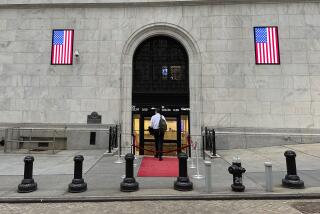Major Markets Impose Curbs on Trading to Cut Price Swings
To the uninitiated, the scene would have seemed bizarre.
After only one minute of heated commodities trading, everything just stopped. For an hour, traders at the New York Mercantile Exchange milled about, drank coffee and contemplated the situation in the Middle East.
Only the so-called “circuit breakers” were in action.
On Thursday--one of the busiest and most tumultuous days for stock and futures markets in years--several exchanges, including the New York Stock Exchange, the New York Mercantile Exchange and the Chicago Mercantile Exchange, curbed trading activity for minutes or hours as stock prices soared and commodity prices plunged.
These trading curbs, commonly known as circuit breakers, are designed to reduce market volatility. What they do is simply stop prices from falling--or rising--so fast that investors have no time to think. Once short “breathing periods” are through, everybody goes back to their posts--hopefully, with a new sense of calm.
At the New York Mercantile exchange, the rules forced a trading halt once the price of crude oil futures fell by $7.50 a barrel in just the first few moments of trading.
At the New York Stock Exchange, a curb on program trading kicked in at 9:44 a.m., incrementally slowing the rise of the Dow Jones industrial average. Meanwhile, the Chicago Mercantile Exchange initiated similar curbs on purchases and sales of contracts based on the price of the Standard & Poors 500 stock index.
Did the trading curbs help reduce volatility?
Considering that stock prices recorded the second-largest one-day rise in history and oil prices exhibited a historic plunge, some market experts are skeptical.
However, at the New York Mercantile Exchange, where trading halts were authorized only last month, some traders believe the break made the market more orderly.
It “was a great release valve,” said Rodney Dow, president of Dow International Energy Corp., after he finished his trading day. “It gave everybody the ability to digest information and prepare trading strategy.” Despite the record one-day loss for oil prices, “the flow of orders was under control,” he added.
More to Read
Inside the business of entertainment
The Wide Shot brings you news, analysis and insights on everything from streaming wars to production — and what it all means for the future.
You may occasionally receive promotional content from the Los Angeles Times.










